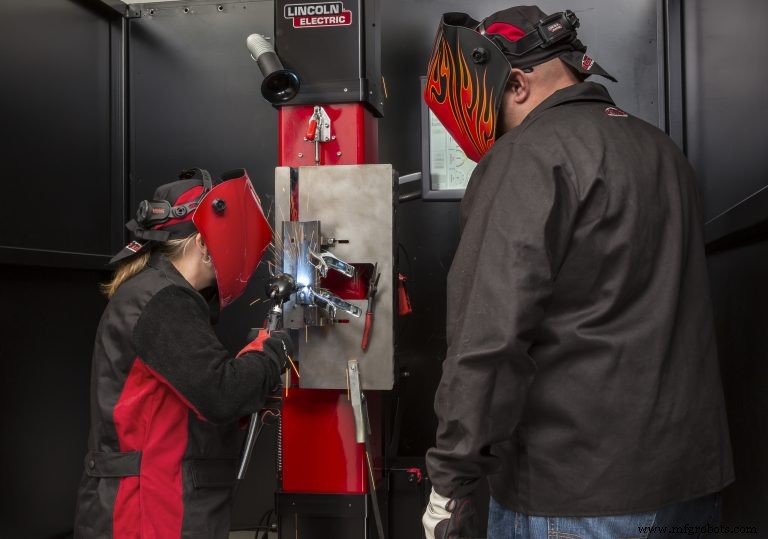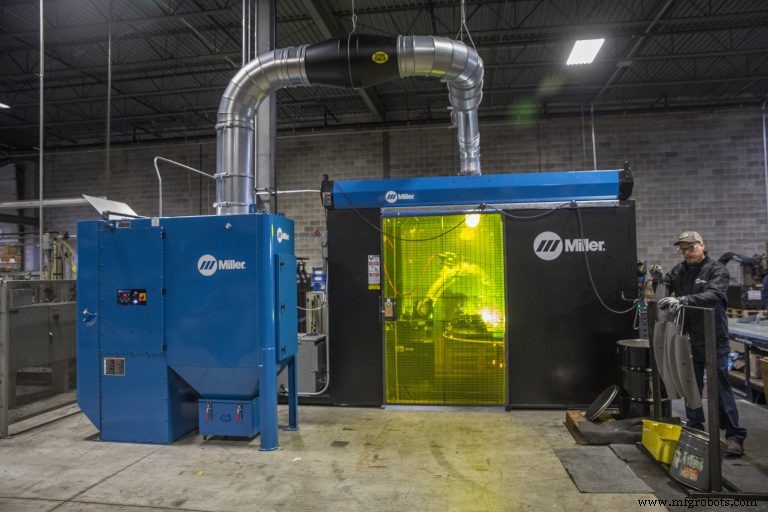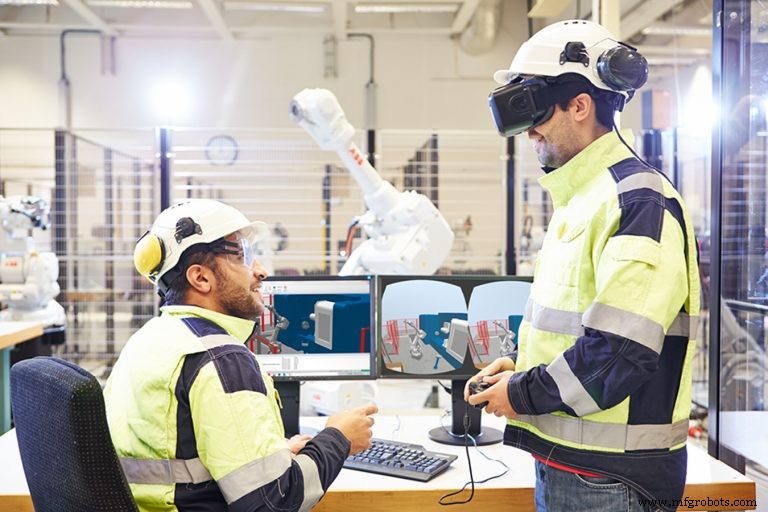新技术推动机器人焊接的发展
现在是自动化焊接操作的最佳时机吗?担心您可以保留经验丰富的焊工多久?需要增加您的吞吐量,但不知道如何利用可用的劳动力?受到更坚韧的材料的挑战?各种技术进步使得通过自动化焊接操作来解决这些问题变得相对容易,而且回报快得惊人。
快三倍

自动化焊接有两大类,即所谓的“固定”自动化和“柔性”(或机器人)焊接。固定自动化通常特定于应用程序,最好在零件几何形状和焊缝非常简单的情况下进行。例如,它通常是焊接管道的最佳解决方案。但对于大多数工业应用和任何复杂的事物,机器人焊接都是理想的选择,也是本文的重点。
正如林肯电气公司(克利夫兰)内部销售经理 Jason Lange 解释的那样,“机器人的主要目的是帮助提高焊接的可重复性。第二是减少对焊工的滥用。整天移动部件并在不同的固定装置下爬行对人类来说是一种负担。机器人有助于人体工学。”
让焊工更容易使用是双重重要的,因为他们越来越难找到。 “全国有很多科技学校投资于焊接项目,试图帮助弥合这一差距,”兰格继续说道。 “但在任何一天,退休的人数都超过了接班人,造成了空缺。机器人焊接有助于填补这一空白。”

与此同时,“机器人系统的回报通常比你想象的要好得多,”米勒电气制造公司(威斯康星州阿普尔顿)的激光部门业务开发经理 Erik Miller 解释道。 “一个机器人系统可以制造与三名焊工一样多的零件。您每班节省两份工资,平均预制单元成本为 100,000 美元到 120,000 美元。它在大约一年内收回成本。通常,如果您可以自动化流程并在不到一年的时间内获得回报,那么您就可以立即采取行动。如果是两年,那是你应该认真考虑的事情。”
因此,机器人自动化对提高吞吐量有很大帮助。但本文采访的消息人士强调,它不能替代熟练劳动力。 “你仍然需要一个高素质的焊接人员来运行那个机器人,”正如兰格所说。
改变材料是自动化的另一个原因

ABB 机器人公司(密歇根州奥本山)焊接与切割业务线总监 Erwin DiMalanta 表示,过去十年中工作材料的变化推动了焊接技术的进步,其中许多是无法手动应用的,例如激光焊接。 . “从采矿车到汽车的各种制造商都在使用不同的材料来降低成本和重量,并适应不同的动力系统解决方案,”他说。 “汽车制造商已转向使用更高强度和超高强度钢,这些钢具有冶金特性,使其更坚固、更轻、更耐腐蚀,同时具有高成型性和可焊接性。这极大地改变了金属结构的设计、成型和组装方式。”制造商可能已经使用传统冲压模具来切割零件的特征,但他们现在正在使用热冲压工艺和自动化激光技术来成型和切割零件。
“另一个例子是更多应用转向铝材,”DiMalanta 说。 “根据汽车的不同,现在多达 90% 的车身可能是铝制的。由于其较高的导电性,您需要更多的电流来点焊铝,而电流就是热量的代名词。然而,我们将采用更薄的规格材料。在某些车辆中,材料的厚度约为 1 毫米。那么你如何应对这些背道而驰的趋势呢?”
答案是改进了电弧焊的电子和机械控制技术,并增加了激光焊接的使用。对于电弧焊,DiMalanta 说:“电源现在非常先进并且是电子控制的。材料在熔池中的沉积是经过精心控制的,具有定制的波形。” Miller 补充说,这种特殊的波形“可以控制零件上的热量输入,从而减少变形,还可以改善焊缝的外观。”
他还指出了松下的一种名为 Active Wire 的机械方法。 “这是一种双向送丝,其中送丝向前送入以产生短路,然后从水坑中反转,以 120 赫兹重复这种缝纫机式的动作。这减少了热量输入,也大大减少了飞溅。它还提高了每个焊缝上电弧的一致性。它在铝焊接和薄板金属焊接中非常受欢迎。”
DiMalanta 说,组件越轻,材料就必须变得越先进,以便在保持强度的同时允许复杂的结构。 “机器人及其先进的软件系统有助于将处理这些材料的过程与机器人的路径联系起来。”
激光焊接是一个令人信服的选择
凭借其闪电般快速地焊接各种材料(包括不同材料)的能力,激光可能是几十年来焊接领域发生的最大事件。正如 Trumpf Inc.(伊利诺伊州霍夫曼庄园)的激光焊接高级高级技术工程师 Masoud Harooni 所说,“近年来激光焊接领域最大的新闻是激光价格的下降。
“激光焊接系统更容易控制,”Harooni 继续说道。 “你选择一种力量和一种速度。调整后,您可以处理整个零件,几乎没有飞溅。在电弧焊中,您必须保持电弧,并且焊接参数对焊枪和工件之间距离的任何变化都很敏感。 [工件] 的不同部分需要更多电流或更少电流,这会导致工艺稳定性降低。尽管现代弧焊系统的反馈回路非常好,但这些系统实际上从未完美调整过。与通常必须研磨的弧焊组件相比,激光焊接组件需要的后处理要少得多。在弧焊系统中,您还有处理飞溅和需要清洁喷嘴的问题。”
或许更重要的是,激光焊接可以在没有热损伤的情况下实现更深的焊接,即使是在铝和镁等易受电弧焊开裂或气孔的材料中也是如此。 Harooni 解释说,这是因为激光可以达到每平方厘米 108 瓦的功率密度。这会产生一个钥匙孔,这是一个通过蒸发工件金属而产生的深空心区域。当激光束沿着零件移动时,它会保持这个被熔池包围的微小锁孔,而后面的材料会凝固。
“你可以在没有极端热量输入的情况下获得坚固、深焊缝,”他说。 “电弧焊没有功率密度,因此实现更深焊接的唯一方法是增加热输入。热输入少、变形小的焊接件的力学性能比热输入高的零件好得多。”
米勒表示,“由于大批量和[技术优势],激光焊接的最初影响是汽车焊接。钣金制造商也应该关注激光焊接。真正的好处在于取代电阻点焊,这对于中小批量制造来说可能具有挑战性。固定可能很困难,因为零件的顶部和底部都需要接触,而激光焊接只需要顶部接触,因此更容易实现自动化。您还可以使用负载较低的机器人进行激光焊接,以及简单的固定光学元件。”
与带有强大手臂的大型负载机器人携带带有两个电极的大型工具相比,制造商现在可以使用更安全的 8 kg 机器人,在其上安装工艺头,并相对轻松地实现电阻点焊自动化。
“在钣金中,激光焊接有利的另一个领域是盒子制造,”他说。 “需要美观的外角焊缝,之后几乎不需要金属表面处理,这是我们看到很多兴趣的领域。”
根据米勒的说法,激光为访问受限的零件提供了一个很好的解决方案。激光只需要视线即可进行焊接,而在弧焊应用中,机器人必须在零件内部和周围移动笨重的焊炬,这可能非常困难。 “在激光焊接中,我们通常距离工件 500 毫米。这就像射击射线枪。激光还具有更高的加工速度和更低的零件总热量输入,从而减少了变形。它是自焊接的完美工具。”
Harooni 解释说,激光焊接的缺点是“要么必须确保组件之间几乎没有间隙,要么使用融合线,将激光焊接与焊丝辅助相结合,将焊丝熔化到熔池中,以便可以弥补缺口。但是激光焊接的速度要快得多,因此在夹具方面的额外投资非常值得。例如,如果您每天使用机器人弧焊制造 50 个零件,那么机器人激光焊接一天可以生产 300、500 甚至数千个相同的零件。”
进入焊接自动化
投入焊接自动化比以往任何时候都容易。首先,主要参与者提供离线设置软件,该软件可以在 PC 上以高度逼真的方式对下一个作业进行编程,将该程序传输给机器人,然后开始焊接。 ABB 甚至使用虚拟现实技术让用户能够与机器人焊接设备“协作”。
DiMalanta 解释说:“可以说,你可以直接抓住机器人的脖子,像对待狗一样指挥它。” “这比使用示教器直观得多。”
其次,这些系统可以具有自动适应从一个零件到下一个零件的位置变化并监控焊接质量的机制。
Miller Electric 的产品专家 David Schaefer 解释说:“有几种传感器类型可以处理关节位置的变化。一种是简单的触摸感应,另一种是弧形接缝跟踪。使用触摸感应时,机器人可以下来并使用其弧焊丝探测零件。它会检查编程位置和实际位置之间的增量,从而基本上重新编程。
“在全弧焊缝跟踪中,当您穿过接头时,如果材料足够厚,则使用角焊缝或搭接焊缝,它会检测电流强度的变化并确定何时进入接头以及何时离开接头。接头,然后在焊接时跟随该焊缝,”Schaefer 继续说道。 “你也可以选择使用激光光学而不是线型传感,但基本思想是一样的。”
林肯电气的兰格说:“另一种方法是通过相机拍摄零件的 2D 或 3D 照片。我们可以根据零件的物理位置偏移程序和偏移关节。较新的相机不会像几年前的相机那样受到部件眩光的影响。他们能够看到更多的颜色并阅读零件的定义,从而将阴影和反射与零件区分开来。” Harooni 补充说:“今天的光学系统还使我们能够实时检查焊缝质量,而无需进行破坏性测试。”
第三,机器人都提供某种形式的碰撞检测。 Miller Electric 的米勒表示,这代表了机器人手臂本身最显着的改进。 “Previously, a customer would create his program based on the known X-Y-Z position of the torch. Let’s say the robot has been welding half the shift and the operator leaves a clamp open. The robot would likely bang into the clamp, bending the torch. That would cause every weld in that program to be out of alignment because the end of the torch has been bent and that position has changed. Today, if the robot hits an object, even at high speed, it reads the resulting current spike as an obstruction. This causes the robot to immediately go into flex servo mode, which delays the application of the brake for a certain distance that’s specified for each axis. The robot goes ‘limp,’ in effect. This allows the robot to dissipate the momentum, minimizing damage to the tool. This means you can have a high-speed collision without bending the torch.”
Four, all the major players offer pre-engineered robotic cells with everything you need on a pallet (or several). “A work cell would be a fully designed unit with all the safeguards in place,” said Lange. “You’d typically see fencing or steel walls, usually safety scanners, lights, push buttons to enable the robot to go, key interlocks, and some sort of positioning device in front of the robot, such as a turntable or a ferris wheel. These devices bring the part into the work zone while the operator loads additional parts on the opposite side. Or you could have just a fixed table where the robot is going to process. There would also be a welding power source, the torch, and some reamers to clean the bits if needed. You just need to connect it to electricity and a gas source.” And if one of the off-the-shelf solutions doesn’t work, customized turnkey solutions are available.
So What’s to Worry About?
“When we consult with a potential customer about welding automation, we look at their upstream fabrication,“ explained Schaefer of Miller Electric. “If they’re using lasers and CNC equipment to bend, brake, and cut the material, they’ll have much better success at robotically welding it than if they were hand cutting it or using a chop saw. Those shops can get away with it now because when they hand weld the parts the welders can adjust accordingly, but the robot won’t.” Miller added that welding is usually the last thing that gets automated at a facility because upstream processes must be accurate first. “Parts have to be cut accurately, then bent accurately. Then you can weld them,” he said.
Besides assuring that parts are repeatable, fixturing that limits or eliminates the gaps is required, as Schaefer explained:“You can’t weld air. A human operator can see a gap and react accordingly, generally by increasing the wire stickout in order to reduce the amperage, which reduces the heat and the penetration, and then start to weave to fill the gap. A robot won’t do this. It will burn through.”
Conversely, Lange said some customers have been spending thousands or hundreds of thousands of dollars in some cases on tooling to hold parts when they could cut that price in half by improving upstream processes. That provides the required repeatability downstream, which ultimately lowers the cost of the tooling and decreases the amount of rework and scrap.
After part quality and repeatability, the next most important concern is “knowing and understanding the welding process as it relates to welds itself and welds through the automated device,” said Lange.
So who should you train to run the automated welding? Either an experienced welder or someone who’s eager to learn welding (which takes weeks) plus welding automation.
Schaefer cautioned that “You need the right culture in the facility. People with jobs can feel threatened by automation coming into the facility. I’d be very up front with my people about the benefits, how it will make the company more efficient, help it grow and be more competitive and ultimately hire more people.”
Finally, batch sizes must be big enough for automation. As Lange put it, “The time it takes to do off-line programming, put in on the robot and do a quick setup definitely produces a good return if your batch sizes run for roughly a day or a day and a half. If you’re changing a part very hour, you might not be quite as effective in ROI.”
自动化控制系统


